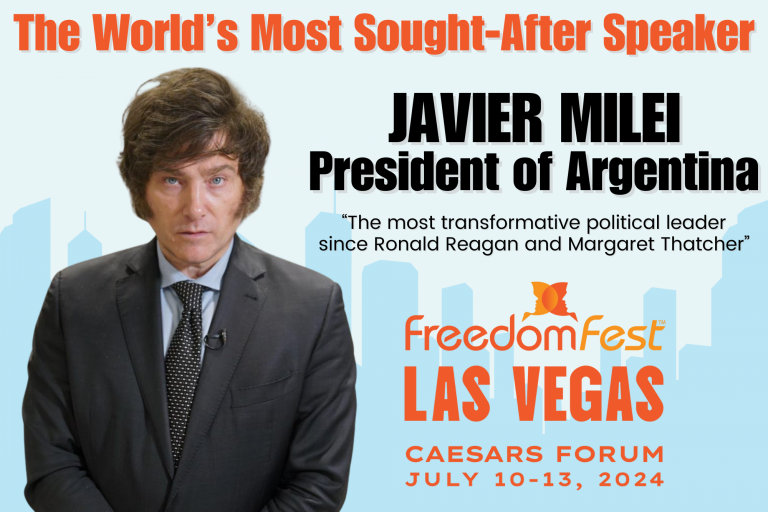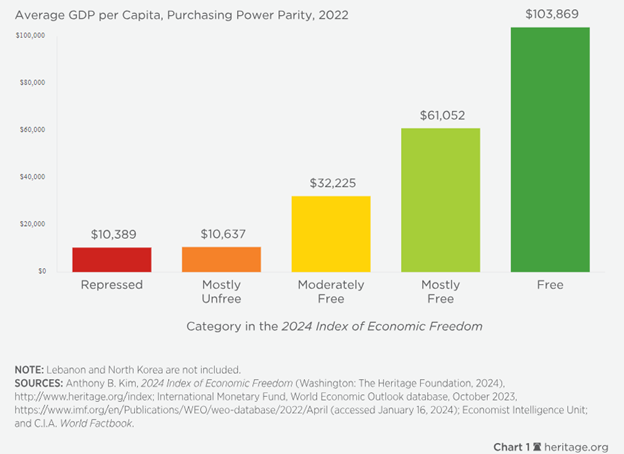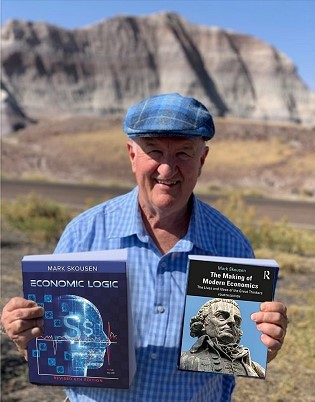Breaking News: My recommendation to invest in emerging markets is paying off. The Argentina Fund is now the top performing country fund in the world, and my best performing investment in 2024 (up 25% so far). President Javier Milei is selling his libertarian message to the world, speaking at Davos and the Milken Conference this year. Next stop: FreedomFest, which Forbes calls “one of the most significant free-market events in the world.”

We are making HISTORY. Here is your chance to meet Milei in person at FreedomFest, July 10-13, at the new Caesars Forum Convention Center in Las Vegas. Now is the time to buy your ticket before we sell out. Use code EAGLE50 when you register here, or call Hayley at 1-855-850-3733 ext. 202.
“A wise and frugal government, which shall restrain men from injuring one another, shall leave them otherwise free to regulate their own pursuits of industry and improvement.” — Thomas Jefferson
“Little else is requisite to carry a state to the highest degree of opulence from the lowest barbarism but peace, easy taxes and a tolerable administration of justice: all the rest being brought about by the natural course of things.” — Adam Smith
I’m reading Joseph Stiglitz’s new book, “The Road to Freedom: Economics and the Good Society.” Available here.
Stiglitz is the former chief economist at the World Bank, a Nobel prize winner and the top economic advisor to President Bill Clinton.
We’ve been friends for many years, since I taught at Columbia Business School in 2004. He has supported by work on gross output (GO). Over the years, I’ve had a lively correspondence with him and his wife, Anya.
Unlike many academics, Joe (as he likes to be called informally) is always willing to engage in a friendly debate. We can disagree without being disagreeable.
As Thomas Jefferson once said, “I never consider a difference of opinion in politics, religion and philosophy as cause for withdrawing from a friend.”
Joe and I disagree strongly on what he calls “neoliberalism,” the philosophy of laissez-faire capitalism espoused by Friedrich Hayek, Milton Friedman, and Ayn Rand, among others.
His book title, “The Road to Freedom,” is written in contrast with Hayek’s “Road to Serfdom.”
He favors what he calls “progressive capitalism,” which entails a much larger role of government in the economy. His book says little good about capitalism itself. He states:
“Globally, government has played an important role in the countries with the highest growth rates… The current neoliberal economic system [free-market capitalism] is not environmentally, socially, politically and economically sustainable.” (p. 235)
Furthermore: “Without strong regulation, neoliberalism will destroy our planet.” (p. 20)
Strong words. Stiglitz favors more environmental, financial and economic regulation… progressive taxation… stronger unions, including the teachers’ unions… and a higher minimum wage.
I think his book should be re-entitled, “The Road to Stagflation.”
What’s Missing: This Amazing Graph
Stiglitz spends a lot of pages attacking the libertarian philosophy of limited government.
In doing so, he fails to address the most influential study in economic freedom ever produced — the Economic Freedom Index, which is published annually by the Fraser Institute in Canada and the Heritage Foundation in the United States. It is the first attempt by economists to demonstrate empirically the case of free-market capitalism, what Stiglitz calls “neoliberalism.”
Here’s the chart:

Clearly, countries with more economic freedom do better economically.
The Fraser Institute and Heritage Foundation also have studies showing that countries with higher levels of economic freedom enjoy a better environment, less poverty and a more fulfilling lifestyle.
Singapore is ranked #1 today in the Economic Freedom Index. Stiglitz fails to mention this example of good governance — government spending is only 10% of gross domestic product (GDP) there; they benefit from free trade, low taxes and the rule of law. See my recent report: From Third World to First World: Who Offers the Best Model of State Capitalism? – Mark Skousen
It’s easy to attack an ideology by “storytelling,” arguing as Stiglitz does that the market economy is responsible for all the evils of the world: “Unfettered markets have created many of the central problems we face, including inequalities, the climate crisis and America’s opioid crisis” (p. 279)
He also blames the market system for the Great Depression and the Financial Crisis of 2008 while ignoring government intervention in the economy that free-market economists like Hayek and Friedman have warned about.
Where to Find a Better ‘Road to Freedom’
My two books, “Economic Logic” (now in its 6th edition) and “The Making of Modern Economics” (4th edition) include a full discussion of the Economic Freedom Index, and why some countries are flourishing and others aren’t.

Learn Sound Economics from ‘Economic Logic’
Based on my “real world” experience, my textbook is very different, based on my living in six countries and traveling through all 50 states and through 80 countries.
It is now in its new 6th edition, published by Capital Press/Regnery. It’s an ideal gift to students or anyone who wants to learn the basics of inflation, taxation, economic growth and ideal government policies.
“Economic Logic” is THE guide to sound economics, all in one book (738 pages). It’s ideal for students and adults alike and is used in introductory courses in colleges around the country.
It is dedicated to Milton Friedman and Friedrich Hayek. Read the book and see why.
For all the details, including chapter headings, click here.
What Economists Are Saying
“Eureka! Skousen has done the impossible. Students love it! I will never use another textbook again.” — Harry Veryser, University of Detroit-Mercy
“Mark Skousen is the only economist I can understand.” — Dr. Lawrence Hayek


